Variations in Root Characteristics and Cadmium Accumulation of Different Rice Varieties under Dry Cultivation Conditions
Abstract
1. Introduction
2. Results
2.1. Effects of Cd Stress on Cd Accumulation in Different Genotypes of Rice under Dry Cultivation Conditions
2.1.1. Effects of Cd Stress Treatments on Cd Concentrations in Various Rice Organs and Rhizosphere Soil under Dry Cultivation Conditions
2.1.2. Effects of Cd Stress Treatments on Rice BCF and TF under Dry Cultivation Conditions
2.1.3. Cluster Analyses Based on Cd Cumulative Trait Phenotypes
2.2. Characteristics of Different Genotypes’ Root Cd Accumulation with Cd Stress Treatments under Dry Cultivation Conditions
2.2.1. The Effects of Cd Stress Treatments on the Root Morphology of Different Genotypes of Rice under Dry Cultivation Conditions
2.2.2. The Effects of Cd Stress on the Anatomic Structure of Roots of Different Rice Genotypes at Maturity under Dry Cultivation Conditions
2.2.3. The Effects of Cd Stress Treatments on the DCB-Fe and DCB-Cd Concentrations of Different Rice Genotypes under Dry Cultivation Conditions
2.3. Correlation Analysis Based on the Cd Accumulation Characteristics of Rice at Maturity
3. Discussion
4. Materials and Methods
4.1. Pot Experiment
4.2. Determination of Cd Concentration
4.3. Determination of Rice Root Morphology and Observation of Root Anatomy
4.4. Statistical Analyses
5. Conclusions
Author Contributions
Funding
Data Availability Statement
Acknowledgments
Conflicts of Interest
References
- Hu, B.; Shao, S.; Ni, H.; Fu, Z.; Huang, M.; Chen, Q.; Shi, Z. Assessment of potentially toxic element pollution in soils and related health risks in 271 cities across China. Environ. Pollut. 2020, 270, 116196. [Google Scholar] [CrossRef] [PubMed]
- Ju, Y.; Luo, Z.; Bi, J.; Liu, C.; Liu, X. Transfer of heavy metals from soil to tea and the potential human health risk in a regional high geochemical background area in southwest China. Sci. Total Environ. 2023, 908, 168122. [Google Scholar] [CrossRef]
- Pinto, A.P.; Mota, A.M.; de Varennes, A.; Pinto, F.C. Influence of organic matter on the uptake of cadmium, zinc, copper and iron by sorghum plants. Sci. Total Environ. 2004, 326, 239–247. [Google Scholar] [CrossRef] [PubMed]
- Huang, M.; Tao, Z.; Lei, T.; Cao, F.; Chen, J.; Yin, X.; Zou, Y.; Liang, T. Improving lodging resistance while maintaining high grain yield by promoting pre-heading growth in rice. Field Crops Res. 2021, 270, 108212. [Google Scholar] [CrossRef]
- Zhang, Q.; He, D.; Zhang, J.; He, H.; Guan, G.; Xu, T.; Li, W.; He, Y.; Zhang, Z. RIP5 Interacts with REL1 and Negatively Regulates Drought Tolerance in Rice. Cells 2024, 13, 887. [Google Scholar] [CrossRef]
- Jia, L.; Hu, C.; Li, Z.; Zhou, J.; Fu, J.; Jia, X. Development Prospect and Strategies of Water-saving and Drought-resistance Rice. Agric. Sci. Technol. 2016, 17, 1125–1128. [Google Scholar] [CrossRef]
- Dong, Y.; Zeng, F.; Yuan, J.; Zhang, G.; Chen, Y.; Liu, X.; Hilario, P.; Ren, T.; Lu, S. Integrated rice management simultaneously improves rice yield and nitrogen use efficiency in various paddy fields. Pedosphere 2020, 30, 863–873. [Google Scholar] [CrossRef]
- Jiang, H.; Xu, X.; Sun, A.; Bai, C.; Li, Y.; Nuo, M.; Shen, X.; Li, W.; Wang, D.; Tian, P.; et al. Silicon nutrition improves the quality and yield of rice under dry cultivation. J. Sci. Food Agric. 2023, 104, 1897–1908. [Google Scholar] [CrossRef]
- Luo, L.; Mei, H.; Yu, X.; Xia, H.; Chen, L.; Liu, H.; Zhang, A.; Xu, K.; Wei, H.; Liu, G.; et al. Water-saving and drought-resistance rice: From the concept to practice and theory. Mol. Breed. 2019, 39, 145. [Google Scholar] [CrossRef]
- Cui, N.; Yin, F.; Gong, D.; He, X.; Chen, F.; Zhao, L.; Zheng, S.; Zhang, Y.; Wu, Z. Water Utilization Status and Suggestions for the Development of Green and Efficient Irrigation and Drainage Technology in the Main Rice-Producing Areas of Southwest China. Strateg. Study CAE 2024, 26, 132–141. [Google Scholar] [CrossRef]
- Deng, X.; Wu, W.; Ma, Q.; Zhao, Y.; Zhang, Q.; Tang, Y.; Luo, S.; Peng, L.; Zeng, Q.; Yang, Y. The impact on Cd bioavailability and accumulation in rice (Oryza sativa L.) induced by dry direct-seeding cultivation method in field-scale experiments. Sci. Total Environ. 2024, 933, 172875. [Google Scholar] [CrossRef] [PubMed]
- Dong, Q.; Wu, Y.; Wang, H.; Li, B.; Huang, R.; Li, H.; Tao, Q.; Li, Q.; Tang, X.; Xu, Q.; et al. Integrated morphological, physiological and transcriptomic analyses reveal response mechanisms of rice under different cadmium exposure routes. J. Hazard. Mater. 2024, 466, 133688. [Google Scholar] [CrossRef] [PubMed]
- Xiao, A.; Chen, D.; Li Wai, C.; Ye, Z. Root Morphology and Anatomy Affect Cadmium Translocation and Accumulation in Rice. Rice Sci. 2021, 28, 594–604. [Google Scholar] [CrossRef]
- Feng, K.; Li, J.; Yang, Y.; Li, Z.; Wu, W. Cadmium Absorption in Various Genotypes of Rice under Cadmium Stress. Int. J. Mol. Sci. 2023, 24, 8019. [Google Scholar] [CrossRef]
- Chi, Y.; Li, F.; Tam, N.F.; Liu, C.; Ouyang, Y.; Qi, X.; Li, W.C.; Ye, Z. Variations in grain cadmium and arsenic concentrations and screening for stable low-accumulating rice cultivars from multi-environment trials. Sci. Total Environ. 2018, 643, 1314–1324. [Google Scholar] [CrossRef] [PubMed]
- Huang, B.; Li, Z.; Li, D.; Yuan, Z.; Nie, X.; Huang, J.; Zhou, Y. Effect of moisture condition on the immobilization of Cd in red paddy soil using passivators. Environ. Technol. 2018, 40, 2705–2714. [Google Scholar] [CrossRef] [PubMed]
- Xu, Y.; Feng, J.; Li, H. Water management increased rhizosphere redox potential and decreased Cd uptake in a low-Cd rice cultivar but decreased redox potential and increased Cd uptake in a high-Cd rice cultivar under intercropping. Sci. Total Environ. 2020, 751, 141701. [Google Scholar] [CrossRef]
- Zhang, Y.; Huang, D.; Zhang, Q.; Xu, C.; Zhu, H.; Zhu, Q. Effects of Water Management on Cadmium Accumulation by Rice (Oryza sativa L.) Growing in Typical Paddy Soil. Environ. Sci. 2021, 42, 2512–2521. [Google Scholar] [CrossRef]
- GB 2762-2022; The National Food Safety Standard-Limits of Contaminants in Food. National Health Commission of the People’s Republic of China and State Administration for Market Regulation: Beijing, China, 2022.
- Liu, B.; Chen, L.; Chen, S.-B.; Li, N.; Zheng, H.; Jin, K.; Pang, H.-C.; Ma, Y.-B. Subcellular Cd accumulation characteristic in root cell wall of rice cultivars with different sensitivities to Cd stress in soil. J. Integr. Agric. 2016, 15, 2114–2122. [Google Scholar] [CrossRef]
- Mei, X.; Li, Q.; Wang, H.; Fang, H.; Chen, H.; Chen, X.; Yang, Y.; Rizwan, M.; Ye, Z. Effects of cultivars, water regimes, and growth stages on cadmium accumulation in rice with different radial oxygen loss. Plant Soil 2020, 453, 529–543. [Google Scholar] [CrossRef]
- Chiao, W.; Chen, B.; Syu, C.; Juang, K. Aspects of cultivar variation in physiological traits related to Cd distribution in rice plants with a short-term stress. Bot. Stud. 2020, 61, 27. [Google Scholar] [CrossRef] [PubMed]
- Huang, B.; Zhao, F.; Wang, P. The relative contributions of root uptake and remobilization to the loading of Cd and As into rice grains: Implications in simultaneously controlling grain Cd and As accumulation using a segmented water management strategy. Environ. Pollut. 2021, 293, 118497. [Google Scholar] [CrossRef] [PubMed]
- Siddique, A.B.; Rahman, M.M.; Islam, M.R.; Naidu, R. Influences of soil pH, iron application and rice variety on cadmium distribution in rice plant tissues. Sci. Total Environ. 2021, 810, 152296. [Google Scholar] [CrossRef] [PubMed]
- Zhou, H.; Zhu, W.; Yang, W.; Gu, J.; Gao, Z.; Chen, L.; Du, W.; Zhang, P.; Peng, P.; Liao, B. Cadmium uptake, accumulation, and remobilization in iron plaque and rice tissues at different growth stages. Ecotoxicol. Environ. Saf. 2018, 152, 91–97. [Google Scholar] [CrossRef]
- Song, T.; Das, D.; Hu, Q.; Yang, F.; Zhang, J. Alternate wetting and drying irrigation and phosphorus rates affect grain yield and quality and heavy metal accumulation in rice. Sci. Total Environ. 2020, 752, 141862. [Google Scholar] [CrossRef]
- Afzal, M.; Yu, M.; Tang, C.; Zhang, L.; Muhammad, N.; Zhao, H.; Feng, J.; Yu, L.; Xu, J. The negative impact of cadmium on nitrogen transformation processes in a paddy soil is greater under non-flooding than flooding conditions. Environ. Int. 2019, 129, 451–460. [Google Scholar] [CrossRef]
- Tai, Y.-P.; Li, Z.-A.; McBride, M.B.; Yang, Y. Dry cultivation enhances cadmium solubility in contaminated soils but minimizes cadmium accumulation in a leafy vegetable. J. Soils Sediments 2017, 17, 2822–2830. [Google Scholar] [CrossRef]
- Li, S.; Wang, G.; Yang, X.; Ke, X.; Huang, L.; Li, Y.; Qiu, Y.; Tao, M.; Hu, Z. Effects of sulfur supply on cadmium transfer and concentration in rice at different growth stages exposed to sulfur-deficient but highly cadmium-contaminated soil. Chem. Biol. Technol. Agric. 2023, 10, 11. [Google Scholar] [CrossRef]
- Guo, J.; Chen, M.; Huang, Y.; Xie, S.; Zhang, X.; Zuo, T.; Hu, C.; Wang, G. Chloride application weakens cadmium immobilization by lime in paddy rice soil. Ecotoxicol. Environ. Saf. 2022, 241, 113761. [Google Scholar] [CrossRef]
- Liu, S.; Chen, H.; Ji, X.; Liu, Z.; Xie, Y.; Tian, F.; Pan, S. Remediation potential of rice with high cadmium accumulation to cadmium contaminated farmland. Soc. Agric. Eng. 2021, 37, 175–181. [Google Scholar] [CrossRef]
- Huang, L.; Li, W.C.; Tam, N.F.Y.; Ye, Z. Effects of root morphology and anatomy on cadmium uptake and translocation in rice (Oryza sativa L.). J. Environ. Sci. 2019, 75, 296–306. [Google Scholar] [CrossRef] [PubMed]
- Liu, C.; Lan, M.; He, E.; Yao, A.; Wang, G.; Tang, Y.; Qiu, R. Phenomic and metabolomic responses of roots to cadmium reveal contrasting resistance strategies in two rice cultivars (Oryza sativa L.). Soil Ecol. Lett. 2021, 3, 220–229. [Google Scholar] [CrossRef]
- Meeinkuirt, W.; Phusantisampan, T.; Saengwilai, P. Root system architecture influencing cadmium accumulation in rice (Oryza sativa L.). Int. J. Phytorem. 2019, 21, 19–26. [Google Scholar] [CrossRef] [PubMed]
- Afzal, J.; Hu, C.; Imtiaz, M.; Elyamine, A.M.; Rana, M.S.; Imran, M.; Farag, M.A. Cadmium tolerance in rice cultivars associated with antioxidant enzymes activities and Fe/Zn concentrations. Int. J. Environ. Sci. Technol. 2018, 16, 4241–4252. [Google Scholar] [CrossRef]
- Yang, H.; Yu, H.; Wang, S.; Bayouli, I.T.; Huang, H.; Ye, D.; Zhang, X.; Liu, T.; Wang, Y.; Zheng, Z.; et al. Root radial apoplastic transport contributes to shoot cadmium accumulation in a high cadmium-accumulating rice line. J. Hazard. Mater. 2023, 460, 132276. [Google Scholar] [CrossRef]
- Hazman, M.; Brown, K.M. Progressive drought alters architectural and anatomical traits of rice roots. Rice 2018, 11, 62. [Google Scholar] [CrossRef]
- Atabayeva, S.D.; Rakhymgozhina, A.B.; Nurmahanova, A.S.; Kenzhebayeva, S.S.; Usenbekov, B.N.; Alybayeva, R.A.; Asrandina, S.S.; Tynybekov, B.M.; Amirova, A.K. Rice Plants (Oryza sativa L.) under Cd Stress in Fe Deficiency Conditions. BioMed Res. Int. 2022, 2022, 7425085. [Google Scholar] [CrossRef]
- Lux, A.; Martinka, M.; Vaculík, M.; White, P.J. Root responses to cadmium in the rhizosphere: A review. J. Exp. Bot. 2010, 62, 21–37. [Google Scholar] [CrossRef]
- Qi, X.; Tam, N.F.-Y.; Li, W.C.; Ye, Z. The role of root apoplastic barriers in cadmium translocation and accumulation in cultivars of rice (Oryza sativa L.) with different Cd-accumulating characteristics. Environ. Pollut. 2020, 264, 114736. [Google Scholar] [CrossRef]
- Saengwilai, P.; Meeinkuirt, W.; Phusantisampan, T.; Pichtel, J. Immobilization of Cadmium in Contaminated Soil Using Organic Amendments and Its Effects on Rice Growth Performance. Expo. Health 2019, 12, 295–306. [Google Scholar] [CrossRef]
- Fu, Y.; Yang, X.; Shen, H. Root iron plaque alleviates cadmium toxicity to rice (Oryza sativa) seedlings. Ecotoxicol. Environ. Saf. 2018, 161, 534–541. [Google Scholar] [CrossRef] [PubMed]
- Wu, Q.; Mou, X.; Wu, H.; Tong, J.; Sun, J.; Gao, Y.; Shi, J. Water management of alternate wetting and drying combined with phosphate application reduced lead and arsenic accumulation in rice. Chemosphere 2021, 283, 131043. [Google Scholar] [CrossRef] [PubMed]
- Li, H.; Zhang, H.; Yang, Y.; Fu, G.; Tao, L.; Xiong, J. Effects and oxygen-regulated mechanisms of water management on cadmium (Cd) accumulation in rice (Oryza sativa). Sci. Total Environ. 2022, 846, 157484. [Google Scholar] [CrossRef]
- Tian, X.; Chai, G.; Lu, M.; Xiao, R.; Xie, Q.; Luo, L. A new insight into the role of iron plaque in arsenic and cadmium accumulation in rice (Oryza sativa L.) roots. Ecotoxicol. Environ. Saf. 2023, 254, 114714. [Google Scholar] [CrossRef] [PubMed]
- Chen, Z.; Tang, Y.-T.; Yao, A.-J.; Cao, J.; Wu, Z.-H.; Peng, Z.-R.; Wang, S.-Z.; Xiao, S.; Baker, A.J.M.; Qiu, R.-L. Mitigation of Cd accumulation in paddy rice (Oryza sativa L.) by Fe fertilization. Environ. Pollut. 2017, 231, 549–559. [Google Scholar] [CrossRef]
- Wang, J.; Wang, P.M.; Gu, Y.; Kopittke, P.M.; Zhao, F.J.; Wang, P. Iron-Manganese (Oxyhydro)oxides, Rather than Oxidation of Sulfides, Determine Mobilization of Cd during Soil Drainage in Paddy Soil Systems. Environ. Sci. Technol. 2019, 53, 2500–2508. [Google Scholar] [CrossRef]
- Tan, Y.; Xu, X.; Ding, Y.; Zheng, X.; Dai, L.; Feng, R.; Shi, R.; Zhou, L.; Chen, P.; Yang, B. Genotypic variation of arsenic and cadmium uptake by upland rice. J. Agro-Environ. Sci. 2016, 35, 1436–1443. [Google Scholar] [CrossRef]
- Yang, J.; Wu, Q.; Fan, Z.; Feng, R. Risks for Using FeCl3 Under a Submerged Condition, and Different Water Management to Reduce Uptake of Antimony and Cadmium in a Rice Plant. Front. Environ. Sci. 2021, 9, 780961. [Google Scholar] [CrossRef]
- Yang, X.; Lin, R.; Zhang, W.; Xu, Y.; Wei, X.; Zhuo, C.; Qin, J.; Li, H. Comparison of Cd subcellular distribution and Cd detoxification between low/high Cd-accumulative rice cultivars and sea rice. Ecotoxicol. Environ. Saf. 2019, 185, 109698. [Google Scholar] [CrossRef]
- Ouyang, W.; Yin, X.; Yang, J.; Struik, P.C. Comparisons with wheat reveal root anatomical and histochemical constraints of rice under water-deficit stress. Plant Soil 2020, 452, 547–568. [Google Scholar] [CrossRef]
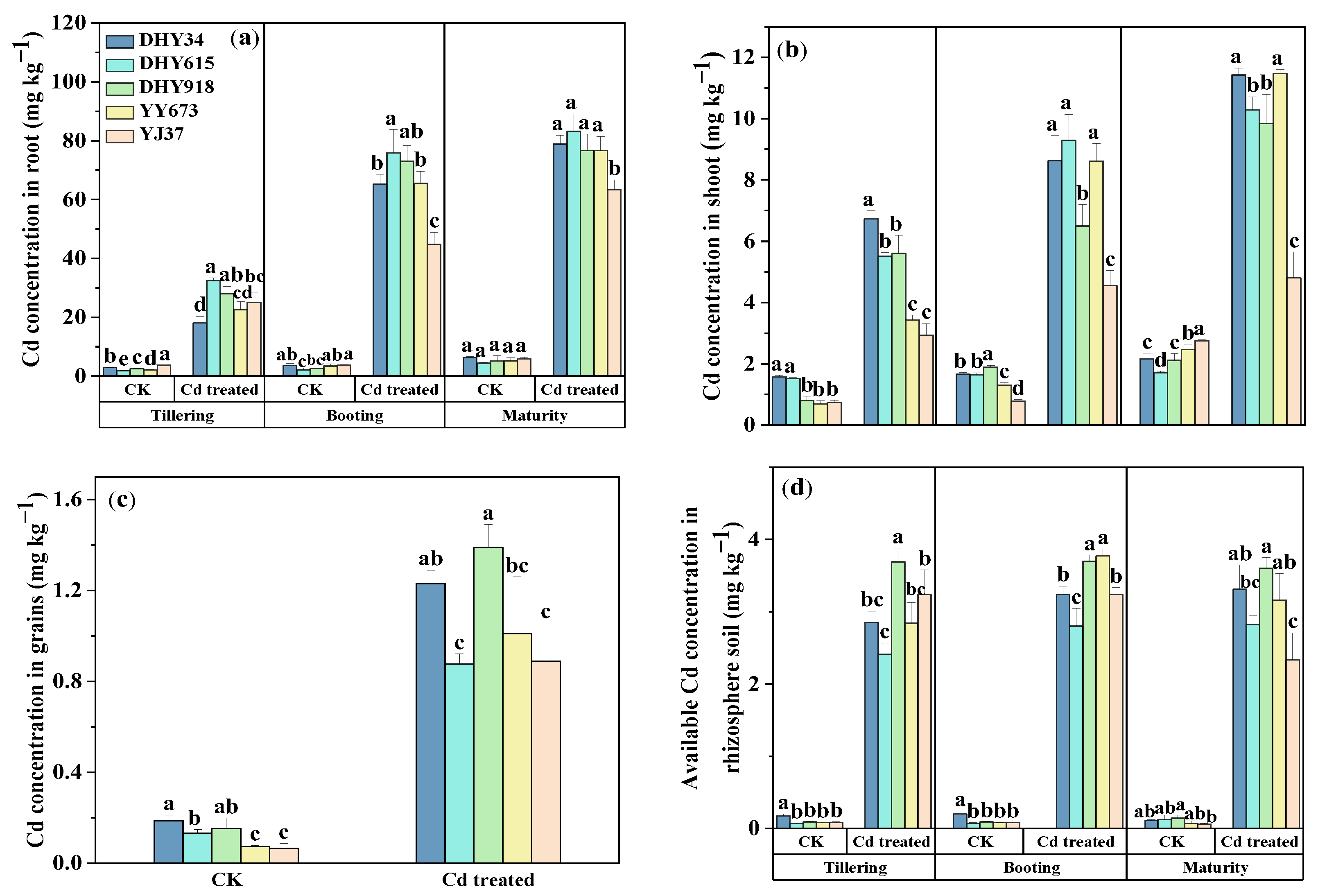
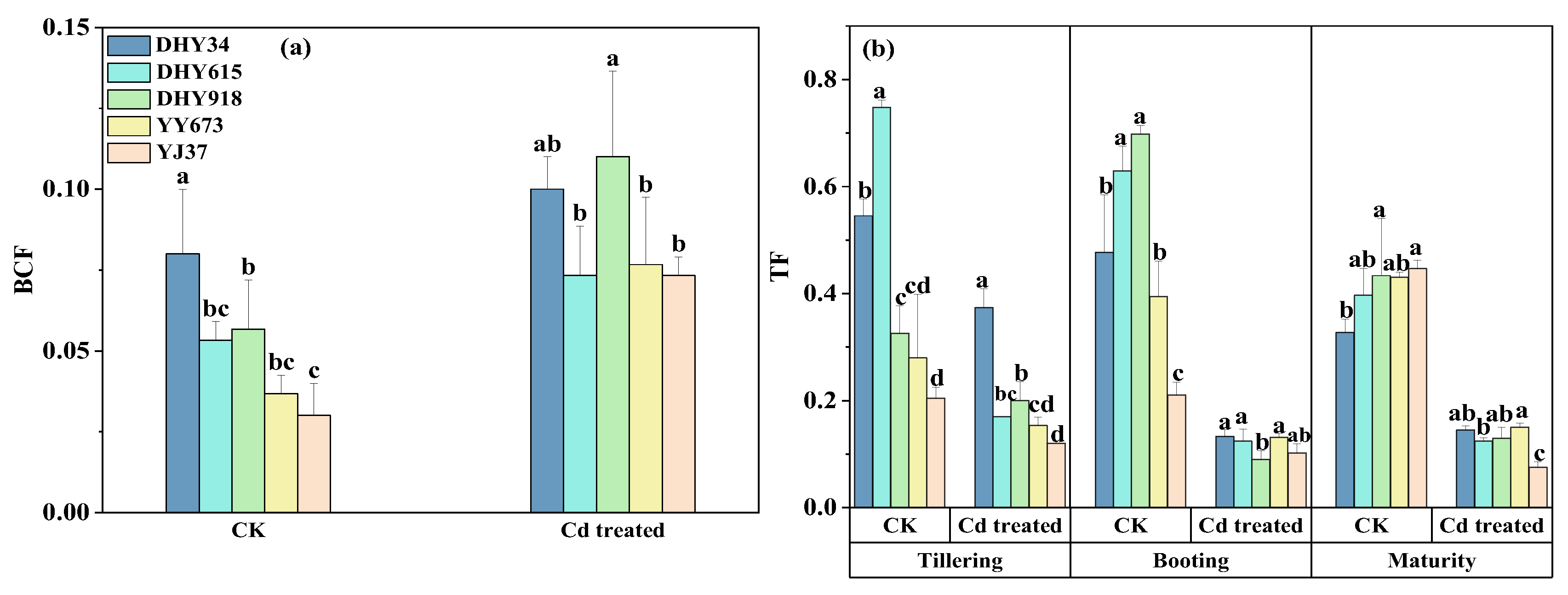

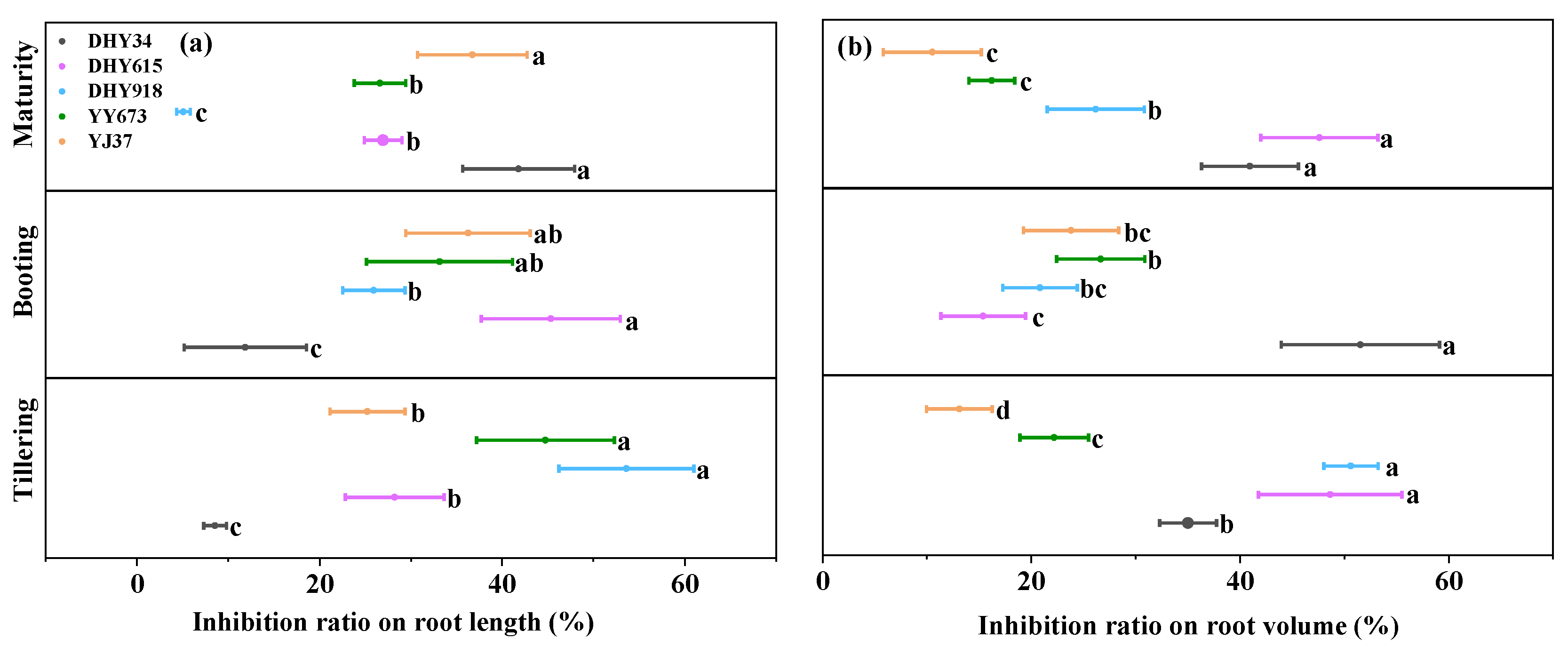
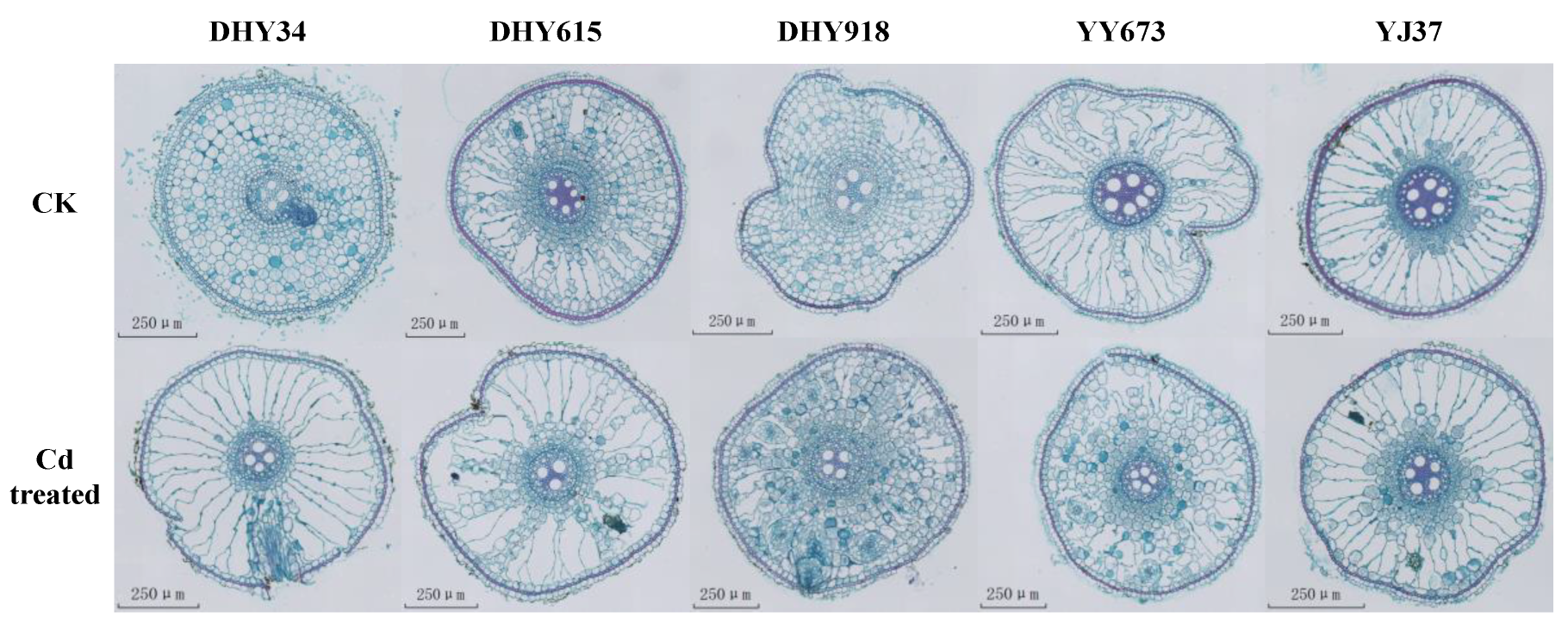
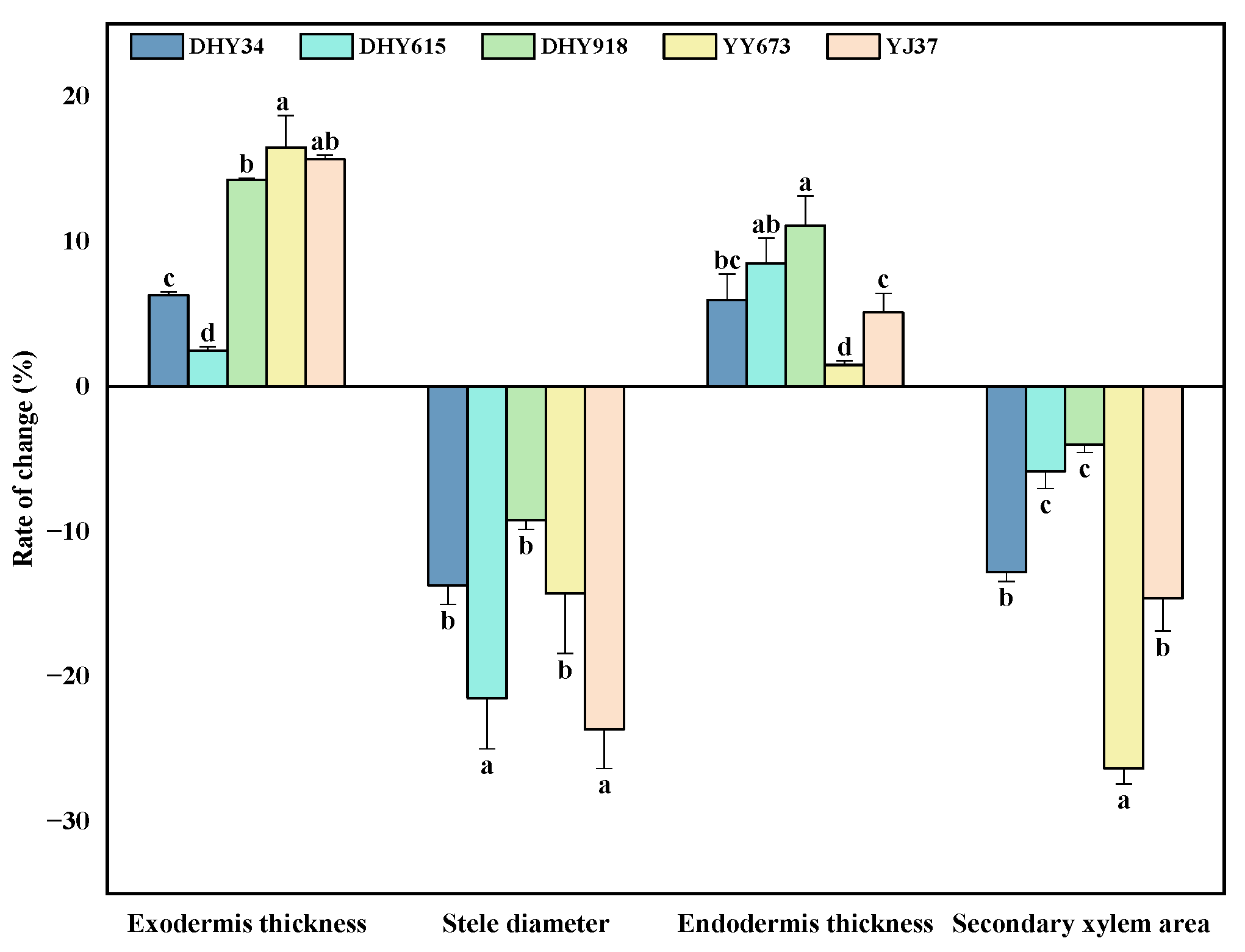


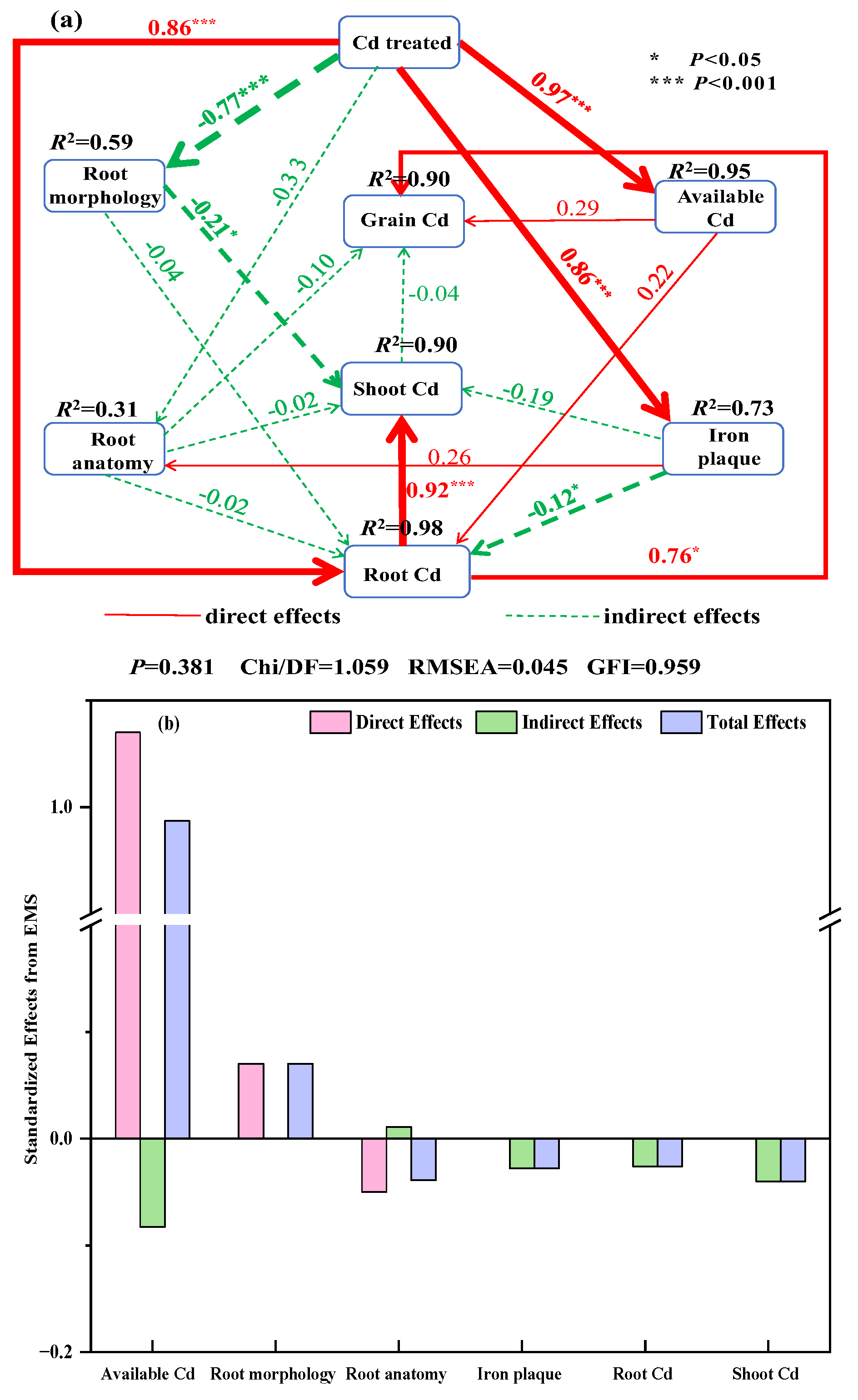
Disclaimer/Publisher’s Note: The statements, opinions and data contained in all publications are solely those of the individual author(s) and contributor(s) and not of MDPI and/or the editor(s). MDPI and/or the editor(s) disclaim responsibility for any injury to people or property resulting from any ideas, methods, instructions or products referred to in the content. |
© 2024 by the authors. Licensee MDPI, Basel, Switzerland. This article is an open access article distributed under the terms and conditions of the Creative Commons Attribution (CC BY) license (https://creativecommons.org/licenses/by/4.0/).
Share and Cite
Shan, C.; Shi, C.; Liang, X.; Zu, Y.; Wang, J.; Li, B.; Chen, J. Variations in Root Characteristics and Cadmium Accumulation of Different Rice Varieties under Dry Cultivation Conditions. Plants 2024, 13, 2457. https://doi.org/10.3390/plants13172457
Shan C, Shi C, Liang X, Zu Y, Wang J, Li B, Chen J. Variations in Root Characteristics and Cadmium Accumulation of Different Rice Varieties under Dry Cultivation Conditions. Plants. 2024; 13(17):2457. https://doi.org/10.3390/plants13172457
Chicago/Turabian StyleShan, Chaoping, Can Shi, Xinran Liang, Yanqun Zu, Jixiu Wang, Bo Li, and Jianjun Chen. 2024. "Variations in Root Characteristics and Cadmium Accumulation of Different Rice Varieties under Dry Cultivation Conditions" Plants 13, no. 17: 2457. https://doi.org/10.3390/plants13172457
APA StyleShan, C., Shi, C., Liang, X., Zu, Y., Wang, J., Li, B., & Chen, J. (2024). Variations in Root Characteristics and Cadmium Accumulation of Different Rice Varieties under Dry Cultivation Conditions. Plants, 13(17), 2457. https://doi.org/10.3390/plants13172457






